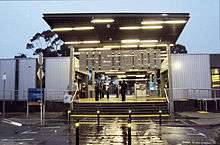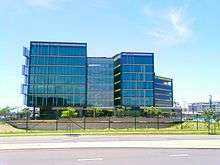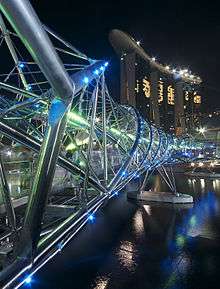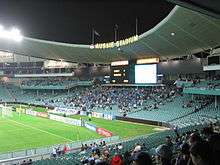Philip Cox
| Philip Cox AO | |
|---|---|
| Born |
Philip Sutton Cox 1 October 1939 NSW, Australia |
| Nationality | Australian |
| Alma mater | |
| Occupation | Architect |
| Spouse(s) | Louise (sep. 1988)[1] |
| Partner(s) | Janet Hawley |
| Children | 2 daughters (with Louise)[1] |
| Practice | COX Architects (1963- )[1] |
| Buildings | |
| Projects | Sydney Olympic Park |
| Website | www.coxarchitecture.com.au |



Philip Sutton Cox AO (born 1 October 1939) is an Australian architect. Cox is the founding partner of COX Architects, one of the largest architectural practices in Australia.
He commenced his first practice with Ian McKay in 1963, then, in 1967 he founded his own practice, Philip Cox and Associates.[1][2] The firm has grown to become Cox Architects and Planners, which has 500 staff.[3] Involved in much of concept design for each project over fifty years, Cox stepped back from the business in 2015 that is now responsible for projects throughout Australia and also in South-East Asia, China, the Middle East, South Africa and Europe. He has been described as “epitomising the Sydney School of Architecture” in earlier projects.[4][5] His work has won him multiple awards, the first being in 1963, one year after graduating from the University of Sydney. His most recent award was in 1989.[1]
Early years and education
Philip Sutton Cox was born on 1 October 1939 to Ron and May Cox. He was their second child. He has one older sister, Judith. His childhood was comfortable, growing up in Killara on the North Shore in Sydney but he was born just one month after the start of the Second World War, which ended when he was six.
Cox attended Gordon Public School and then the Sydney Church of England Grammar School (Shore) in North Sydney. In his first years at Shore, art was taught by John Lipscombe, who had helped plan the new art block which had been praised by the architect Harry Seidler, who had lectured in the building in July 1952. Cox decided at quite an early age that he wanted to be an architect, though this was not clear until it was nearly time to leave school. He won a Commonwealth scholarship which was to pay his fees.[6]
Cox studied at the University of Sydney between 1957 and 1962, where he graduated with a Bachelor of Architecture, then at the University of New South Wales between 1970 and 1975, where he was awarded a Doctorate of Science.[6]
Major architectural works
Cox was the architect responsible for initially implementing the American Radburn design for public housing in New South Wales.
Cox and his firm have designed many iconic public buildings in Australia and throughout South East Asia including a number of the buildings used for the Sydney Olympics. The following list provides a summary of some of the major architectural design works of Cox and his firm, ordered from earliest to most recent, where Cox has either worked individually or as part of consortia:
| Completed | Project name | Location | Award | Notes |
|---|---|---|---|---|
| 1963 | St Andrews Presbyterian Church | Leppington, South-western Sydney, New South Wales | John Sulman Medal (1965) | (demolished)[2][7] |
| 1965 | C B Alexander Agricultural College | Tocal, Hunter region, New South Wales |
| [1][2] |
| 1969 | Hawkins Residence | 19 Norma Crescent, Cheltenham | Wilkinson Award (1969) | [4] |
| 1977 | Bruce Stadium | Bruce, Canberra, Australian Capital Territory | [1][8] | |
| 1985 | Ayres Rock Resort | Yulara, Northern Territory | Sir Zelman Cowen Award (1985) | [1] |
| 1987 | Haileybury Chapel | Springvale Road, Melbourne, Victoria | ||
| 1988 | Sydney Convention and Exhibition Centre | Darling Harbour, Sydney, New South Wales | John Sulman Medal (1989) | (demolished 2013)[9] |
| 1988 | Rod Laver Arena | Flinders Park, Melbourne, Victoria | (refurbished 1995)[8] | |
| 1991 | Australian National Maritime Museum | Darling Harbour, Sydney, New South Wales | [10] | |
| 1988 | Sydney Football Stadium | Moore Park, Sydney, New South Wales | [8] | |
| 1995 | Brisbane Convention & Exhibition Centre | South Bank, Brisbane, Queensland | ||
| 1994 | Sydney Olympic Park Aquatic Centre | Sydney Olympic Park, Sydney, New South Wales | ||
| 1997 | Sydney Harbour Casino | Darling Harbour, Sydney, New South Wales | [8] | |
| 1999 | Sydney Super Dome | Sydney Olympic Park, Sydney, New South Wales | ||
| 1999 | Singapore Expo | Changi, Singapore | ||
| 2001 | National Wine Centre of Australia | North Terrace, Adelaide, South Australia | [11] | |
| 1996 | Cairns Convention Centre | Cairns, Queensland | ||
| 2000 | Princess Alexandra Hospital Redevelopment | Woolloongabba, Brisbane, Queensland | ||
| 2001 | Goodwill Bridge | South Bank, Brisbane, Queensland | [12] | |
| 2002 | Western Australian Maritime Museum | Victoria Quay, Fremantle, Western Australia | ||
| 2004 | Brisbane Magistrates Court | George Street, Brisbane, Queensland | ||
| 2005 | Challenger Institute of Technology, Marine Campus | Fremantle, Western Australia | ||
| 2006 | Melbourne Cricket Ground, Northern Stand | |||
| 2007 | National Institute of Circus Arts | Prahran, Melbourne, Victoria | Award for Architectural Steel Design – Large Project, Australian Steel Institute VIC (2008) | |
| District Court of Western Australia | Perth, Western Australia | |||
| 2008 | Australian Film, Television and Radio School | Moore Park, Sydney, New South Wales | State Commendation for Commercial Architecture, AIA NSW (2010) | |
| 2010 | Energex Headquarters | Newstead, Brisbane, Queensland | ||
| 2010 | The Helix | Marina Bay, Singapore | [13] | |
| 2010 | AAMI Park | Sports and Entertainment Precinct, Melbourne, Victoria | World’s Most Iconic and Culturally Significant Stadium, World Stadium Congress (2012) National Award for Public Architecture, AIA (2011) State Architecture Medal, AIA VIC, (2011) William Wardell Award for Public Architecture, AIA VIC (2011) | [8] |
| 2012 | One One One Eagle Street | Brisbane CBD, Queensland | John Dalton Award for Building of the Year, AIA QLD (2013) Corian Design Awards Winner (Project) (2015) | [14] |
| 2012 | Queensland Performing Arts Centre Refurbishment | South Bank, Brisbane, Queensland | Interior Design Impact Award, AIDA (2016) | |
| 2013 | Neuroscience Research Australia | Randwick, Sydney, New South Wales | The People’s Choice Award, Randwick City Council (2013) | |
| 2014 | Kaohsiung Exhibition Center | Kaohsiung, Taiwan | Excellence Award, Chinese Institute of Engineers (2014) | [15] |
| 2015 | Carnarvon Police and Justice Complex | Carnarvon, Western Australia | ||
| 2016 | Anna Meares Velodrome | Chandler, Brisbane, Queensland | Venue for 2018 Commonwealth Games | [16] |
| 2018 | Sir John Monash Centre | Villers-Bretonneux, France | [17] | |
| under construction | Jakarta International Velodrome | Jakarta, Indonesia | ||
| under construction | Newcastle Courthouse | Newcastle, New South Wales | ||
| under construction | Oman Across Ages Museum | Muscat, Oman | ||
| under construction | National Maritime Museum of China | Tianjin, China | ||
| under construction | Christchurch Justice and Emergency Services Precinct | Christchurch, New Zealand |
Awards
Cox has received numerous awards in recognition of his contribution to architecture, including the Sir Zelman Cowen Award, the RAIA Gold Medal in 1984, Life Fellowship to the RAIA in 1987 and Honorary Fellowship of the American Institute of Architects in the same year. In 1988 he was appointed an Officer of the Order of Australia in recognition of service to architecture.[18] In 1993 he received the inaugural award for Sport and Architecture from the International Olympic Committee, and is a Fellow of the Australian Academy of the Humanities.
Cox has held a range of voluntary positions during his professional career including Vice President, Environment Board, RAIA, NSW Chapter; a Member, Historic Buildings Committee, Cancer Patients Assistance Society of NSW; Vice President, Cancer Patients Assistance Society of NSW; Vice Chairman, Architecture and Design Panel, Visual Arts Board, Australia Council; and Chairman of Education Board of the RAIA, Federal Chapter.
Personal life
Cox is married to Louise Cox AO, a fellow architect. They married in Sydney in April 1972. They have two daughters, Charlotte and Sophie.[6]
References
- 1 2 3 4 5 6 7 8 Bleby, Michael (20 August 2016). "Architect Philip Cox delivers upfront on architecture's deficiencies". Financial Review. Australia. Retrieved 20 August 2016.
- 1 2 3 Cox, Philip (7 September 2015). "Vale Ian McKay". Architecture AU. Retrieved 20 August 2016.
- ↑ "Cox Architects official website".
- 1 2 Lynch, Owen (10 September 2013). "Philip Cox: A half century". In design live. Retrieved 20 August 2016.
- ↑ "ULTIMATEHIDES website".
- 1 2 3 Towndrow, Jennifer (1991). Philip Cox. Portrait of an Australian Architect. Penguin Books Australia.
- ↑ Rushton, Gina (17 April 2014). "Philip Cox bristling at garden plan critics". The Australian. Retrieved 20 August 2016.
- 1 2 3 4 5 Pickett, Charles (4 November 2013). "Casinos and stadiums: Philip Cox". Inside the collection. Museum of Applied Arts & Sciences. Retrieved 21 August 2016.
- ↑ Hasham, Nicole (16 January 2013). "Architect lashes out at 'stupid' demolition". The Sydney Morning Herald.
- ↑ Meacham, Steve (3 December 2001). "How the museum boss got engaged". The Sydney Morning Herald. p. 14.
- ↑ Australian Institute of Architects: "National Wine Centre", retrieved 15 November 2013
- ↑ Musgrave, Elizabeth (September 2002). "Goodwill overture". Architecture Australia. 91 (5): 66. ISSN 0003-8725. Retrieved 20 July 2011.
- ↑ "Helix Bridge / Cox Architecture with Architects 61". ArchDaily. 10 January 2012. Retrieved 19 August 2016.
- ↑ "One One Eagle Street / Cox Rayner Architects". ArchDaily. 15 May 2013. Retrieved 20 August 2016.
- ↑ "Cox wins Taiwanese project". Architecture & Design. 27 August 2010. Retrieved 20 August 2016.
- ↑ "Sleeman Sports Complex Anna Meares Velodrome". Stadiums Queensland. Retrieved 7 January 2018.
- ↑ Crowe, David (24 April 2018). "'We must remember': PM opens $100m Monash centre in France". The Sydney Morning Herald. Retrieved 25 April 2018.
- ↑ Officer of the Order of Australia (AO) entry for COX, Philip Sutton, Canberra, Australia: Department of the Prime Minister and Cabinet, 26 January 1988, https://www.itsanhonour.gov.au/honours/honour_roll/search.cfm?aus_award_id=869645&showInd=true. Retrieved 21 August 2016
Further reading
- Cox, Philip Sutton (1997). Cox Architects : selected and current works.
- Cox, Philip Sutton; Harrison, Stuart; Kaji-O'Grady, Sandra; Johnson, Anna (2008). Cox Architects & Planners.
- A decade in review: Philip Cox. Australian Design Review.
- Australian Architects: Philip Cox. Canberra: Royal Australian Institute of Architects. 1984.
- Australian Architects: Philip Cox, Richardson & Taylor. Canberra: Royal Australian Institute of Architects. 1988.
- Pickett, Charles (Curator) (4 November 2013). "Casinos and stadiums: Philip Cox". Inside the collection. Museum of Applied Arts & Sciences. Retrieved 21 August 2016.
External links
- "Profile: Philip Cox AO". Cox Architects.
- "Search projects: Cox Rayner Architects". ArchDaily. 2016.
- Cox, Philip (9 August 1999). "Phillip Cox and The Spirit of Place". Late Night Live (Interview). Interviewed by Phillip Adams. Australian Broadcasting Corporation – via Radio National.
- "Search of Collection: Philip Cox". Museum of Applied Arts & Sciences.
- "Philip Cox". Travel Australia. www.travel-australia.org. 2011.
- Philip Cox unleashed - ABC radio
